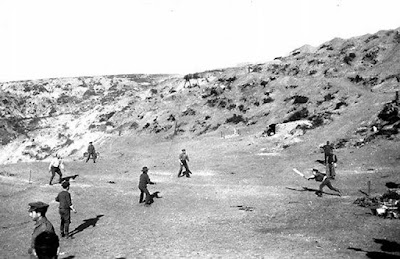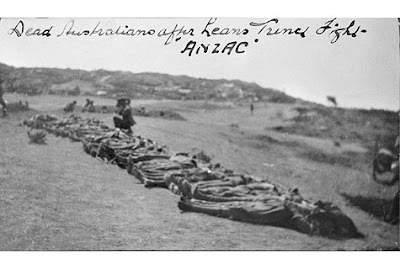Australian War Memorial image: H00345
December 1915
This War Memorial image shows a view of Shell Green looking downhill and to the west. Before the Great War, this small plot of flat-ish ground was used by the Turkish farmers to grow cotton. Apart from the narrow strip of sandy beach, it was the only land suitable for cricket around Anzac cove. Unfortunately it was clearly visible from the Turkish lines. The players decided to go ahead anyway.
The idea was to deceive the Turks into thinking that all was normal. In fact, the evacuation of Allied troops had already begun. The 5th Battalion was already back on Lemnos Island and the last troops were to depart three days later on 20 December 1915. The cricket game ceased when shells landed nearby.
CEW Bean's photograph of the cricket match on Shell Green.
Australian War Memorial image: G01289
Batting at the southern end is Major George Macarthur-Onslow of the Australian 7th Light Horse. You might note his wonderful follow-through, the close-in fielders, and lack of crowd cheering them on. Apparently the Major was the leading figure in this venture, both as organiser and batsman.
Major Macarthur-Onslow was born in Australia, at 'Camden Park', Menangle. He was a descendant of John Macarthur who arrived in Sydney on the HMS Scarborough with the second fleet. Major Macarthur-Onslow was educated at Rugby school in England and was commissioned in the NSW Mounted Rifles in 1895. He remained a career army officer after the war and later pursued other business and political interests. The Australian Dictionary of Biography notes that according to Sir Harry Chauvel, Major Macarthur-Onslow was 'full of dash and initiative, quite fearless and possessing the entire confidence of his men'.
A cousin of mine (Charlie M) recalls meeting, on a number of occasions, an elderly friend of his grandfather's, a Frank Buckle, who may have played in the famous Shell Green cricket match. Frank was a very capable sportsman scoring 270 for North Sydney against Paddington in the 1920-1 season in the 2nd Grade. He went on to become the 1st captain of the Northern Districts cricket team.
Frank also played two games for the NSW Waratahs (Rugby Union) in 1914 before enlisting.
Corporal Frank Buckle (service number 18373) served with the 7th Field Artillery Brigade. He was a Sydney boy, raised in the suburb of Cremorne. After the war he practiced as an architect.
______________
Today Shell Green is the site of a cemetery containing 429 graves of which 408 are Australian war dead.
One of the men buried here is the brother of A. B. Facey,
author of 'A Fortunate Life'. Roy Facey of the 11th Battalion and
his mate were killed by the same shell. A.B. Facey (Albert) helped to bury his
brother along with the 15 mates all killed on 28 June 1915. A.B. Facey records in
his book:
‘we put them in a grave side by side on the edge of a clearing we called Shell Green. Roy was in pieces when they found him. We put him together as best we could – I can remember carrying a leg – it was terrible’.
Bodies of 11th Battalion members including AB Facey's brother. They are laid out on Shell Green just as told by AB Facey in his book 'A Fortunate Life'. AWM ref: P02023.002
Shell Green cemetery, Commonwealth War Graves Commission image at:



No comments:
Post a Comment
I would be delighted if you would like to share your thoughts...